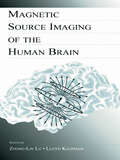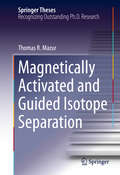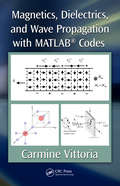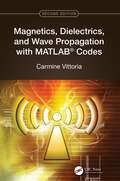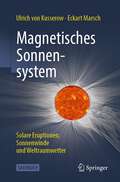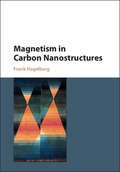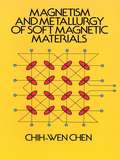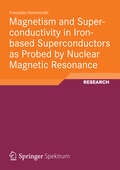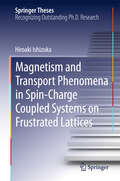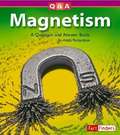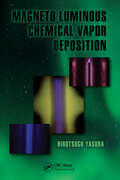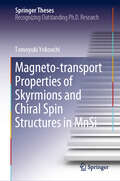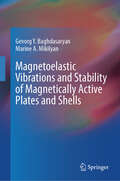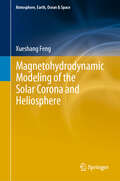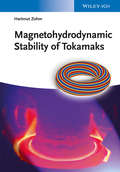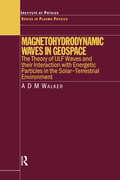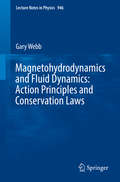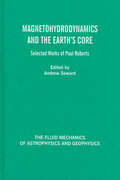- Table View
- List View
Magnetic Source Imaging of the Human Brain
by Lloyd Kaufman Zhong-Lin LuThis book is designed to acquaint serious students, scientists, and clinicians with magnetic source imaging (MSI)--a brain imaging technique of proven importance that promises even more important advances. The technique permits spatial resolution of neural events on a scale measured in millimeters and temporal resolution measured in milliseconds. Although widely mentioned in literature dealing with cognitive neuroscience and functional brain imaging, there is no single book describing both the foundations and actual methods of magnetoencephalopgraphy and its underlying science, neuromagnetism. This volume fills a long-standing need, as it is accessible to scientists and students having no special background in the field, and makes it possible for them to understand this literature and undertake their own research. A self-contained unit, this book covers MSI from beginning to end, including its relationship to allied technologies, such as electroencephalography and modern functional imaging modalities. In addition, the book: *introduces the field to the non-specialist, providing a framework for the rest of the book; *provides a thorough review of the physiological basis of MSI; *describes the mathematical bases of MSI--the forward and inverse problems; *outlines new signal processing methods that extract information from single-trial MEG; *depicts the early, as well as the most recent versions of MSI technology; *compares MSI with other imaging methodologies; *describes new paradigms and analysis techniques in applying MSI to study human perception and cognition, which are also applicable to EEG; and *reviews some of the most important results in MSI from the most prominent researchers and laboratories around the world.
Magnetic Straintronics: An Energy-Efficient Hardware Paradigm for Digital and Analog Information Processing (Synthesis Lectures on Engineering, Science, and Technology)
by Supriyo BandyopadhyayThis book covers the new field of straintronics, using strain switched nanomagnets for extremely energy-efficient computing, information processing, communication, and signal generation. Based on well-established CMOS technology, traditional electronics have two significant shortcomings: excessive energy dissipation and volatility, which is the inability to retain information after power has been switched off. Straintronics is more energy-efficient and non-volatile (but also more error-prone), allowing it to eclipse traditional electronics in niche areas that are increasingly attracting attention, such as image processing and probabilistic computing, computer vision, machine learning, neuromorphic networks, probabilistic computing, and belief networks. Magnetic Straintronics: An Energy-Efficient Hardware Paradigm for Digital and Analog Information Processing introduces straintronics and the technology's myriad applications for researchers, engineers, and scientists in electrical engineering, physics, and computer engineering.
Magnetically Activated and Guided Isotope Separation
by Thomas R. MazurThis thesis describes a proof-of-principle experiment demonstrating a technique for stable isotope enrichment called Magnetically Activated and Guided Isotope Separation (MAGIS). Over the past century many enriched isotopes have become available, thanks largely to electromagnetic separators called calutrons. Due to substantial maintenance and operating costs, the United States decommissioned the last of its calutrons in 1998, leading to demand for alternative methods of isotope separation. The work presented here suggests the promise for MAGIS as a viable alternative to the calutrons. The MAGIS technique combines optical pumping with a scalable magnetic field gradient to enrich atoms of a specific isotope in an atomic beam. Benchmarking this work against the calutron using lithium as a test case, the author demonstrated comparable enrichment in a manner that should scale to the production of similar quantities, while requiring vastly less energy input.
Magnetics, Dielectrics, and Wave Propagation with MATLAB Codes
by Carmine VittoriaBecause future microwave, magnetic resonance, and wave propagation systems will involve miniature devices, nanosize structures, multifunctional applications, and composites of various types of materials, their development requires distinctly multidisciplinary collaborations. That means specialized approaches will not be sufficient to satisfy requir
Magnetics, Dielectrics, and Wave Propagation with MATLAB® Codes
by Carmine VittoriaFuture microwave, wireless communication systems, computer chip designs, and sensor systems will require miniature fabrication processes in the order of nanometers or less as well as the fusion of various material technologies to produce composites consisting of many different materials. This requires distinctly multidisciplinary collaborations, implying that specialized approaches will not be able to address future world markets in communication, computer, and electronic miniaturized products. Anticipating that many students lack specialized simultaneous training in magnetism and magnetics, as well as in other material technologies, Magnetics, Dielectrics, and Wave Propagation with MATLABR Codes avoids application-specific descriptions, opting for a general point of view of materials per se. Specifically, this book develops a general theory to show how a magnetic system of spins is coupled to acoustic motions, magnetoelectric systems, and superconductors. Phenomenological approaches are connected to atomic-scale formulations that reduce complex calculations to essential forms and address basic interactions at any scale of dimensionalities. With simple and clear coverage of everything from first principles to calculation tools, the book revisits fundamentals that govern magnetic, acoustic, superconducting, and magnetoelectric motions at the atomic and macroscopic scales, including superlattices. Constitutive equations in Maxwell’s equations are introduced via general free energy expressions which include magnetic parameters as well as acoustic, magnetoelectric, semiconductor, and superconducting parameters derived from first principles. More importantly, this book facilitates the derivation of these parameters, as the dimensionality of materials is reduced toward the microscopic scale, thus introducing new concepts. The deposition of ferrite films at the atomic scale complements the approach toward the understanding of the physics of miniaturized composites. Thus, a systematic formalism of deriving the permeability or the magnetoelectric coupling tensors from first principles, rather than from an ad hoc approach, bridges the gap between microscopic and macroscopic principles as applied to wave propagation and other applications.
Magnetisches Sonnensystem: Solare Eruptionen, Sonnenwinde und Weltraumwetter
by Eckart Marsch Ulrich von KusserowDie magnetisch aktive Sonne steht im Zentrum unseres Sonnensystems. Aus ihrer Korona strömt der Sonnenwind stetig in alle Richtungen und formt eine großräumige magnetisierte Plasmahülle um unser Zentralgestirn: die Heliosphäre. Zusammen mit der aus dem Interstellaren Medium eindringenden kosmischen Partikelstrahlung prägt der Sonnenwind die Entwicklung des Weltraumwetters im Interplanetaren Raum sowie in den Magnetosphären und Ionosphären der Planeten. Wie entstehen Kometenschweife und Polarlichter? Welchen Einfluss hat der Sonnenwind auf das Leben im Erdsystem?Unterstützt durch faszinierende Abbildungen astronomischer Himmelsobjekte, durch erklärende Grafiken, wissenschaftliche Originaldaten sowie durch die Verknüpfungshinweise zu Videosequenzen werden die zugrundeliegenden physikalischen Prozesse und neuesten Erkenntnisse didaktisch aufbereitet und mit wenigen mathematischen Herleitungen anschaulich erläutert. Dieses Sachbuch wendet sich allgemein an die gebildete Öffentlichkeit, an Amateurastronomen aber auch an junge Studierende, die sich einen umfassenden Überblick über die generelle Bedeutung magnetischer Vorgänge sowie ein tieferes Verständnis der Prozesse in den Weltraumplasmen unseres Sonnensystems verschaffen möchten.
Magnetism In Carbon Nanostructures
by Frank HagelbergMagnetism in carbon nanostructures is a rapidly expanding field of current materials science. Its progress is driven by the wide range of applications for magnetic carbon nanosystems, including transmission elements in spintronics, building blocks of cutting-edge nanobiotechnology, and qubits in quantum computing. These systems also provide novel paradigms for basic phenomena of quantum physics, and are thus of great interest for fundamental research. This comprehensive survey emphasizes both the fundamental nature of the field, and its groundbreaking nanotechnological applications, providing a one-stop reference for both the principles and the practice of this emerging area. With equal relevance to physics, chemistry, engineering and materials science, senior undergraduate and graduate students in any of these subjects, as well as all those interested in novel nanomaterials, will gain an in-depth understanding of the field from this concise and self-contained volume.
Magnetism and Accelerator-Based Light Sources: Proceedings of the 7th International School ‘‘Synchrotron Radiation and Magnetism’’, Mittelwihr (France), 2018 (Springer Proceedings in Physics #262)
by Hervé Bulou Loïc Joly Jean-Michel Mariot Fabrice ScheurerThis open access book collects the contributions of the seventh school on Magnetism and Synchrotron Radiation held in Mittelwihr, France, from 7 to 12 October 2018. It starts with an introduction to the physics of modern X-ray sources followed by a general overview of magnetism. Next, light / matter interaction in the X-ray range is covered with emphasis on different types of angular dependence of X-ray absorption spectroscopy and scattering. In the end, two domains where synchrotron radiation-based techniques led to new insights in condensed matter physics, namely spintronics and superconductivity, are discussed. The book is intended for advanced students and researchers to get acquaintance with the basic knowledge of X-ray light sources and to step into synchrotron-based techniques for magnetic studies in condensed matter physics or chemistry.
Magnetism and Electricity
by The Regents of the University of CaliforniaThese stories allow students to investigate real objects and organisms in the module activities and through these hands-on experiences begin to construct their ideas about the natural world.
Magnetism and Metallurgy of Soft Magnetic Materials
by Chih-Wen ChenSoft magnetic materials are economically and technologically the most important of all magnetic materials. In particular, the development of new materials and novel applications for the computer and telecommunications industries during the past few decades has immensely broadened the scope and altered the nature of soft magnetic materials. In addition to metallic substances, nonmetallic compounds and amorphous thin films are coming increasingly important. This thorough, well-organized volume -- on of the most comprehensive treatments available -- offers a coherent, logical presentation of the physical principles underlying both the intrinsic and applied properties of soft magnetism. Two basic components are stressed: (1) traditional magnetism, which imparts magnetization and spin-dependent properties, and (2) metallurgy, which governs the preparation of the products and the attainment of their structure-sensitive properties. The book comprises seven major chapters: Introduction; Ferromagnetism and Ferrimagnetism; Magnetization and Domain Structure; Magnetic Properties; Metallurgy of Soft Magnetic Materials; Applications of Soft Magnetic Materials; and Special Topics (radiation effects and magnetic bubbles and devices). In addition to an extensive introduction to the basic principles of magnetism relevant to all magnetic materials (Chapters I-IV), Professor Chen (Lawrence Livermore National Laboratory) devotes the core of the book to a rigorous, detailed discussion of the effects of metallurgical factors such as purity, alloying, grain structure, defects, and atomic order on the properties and performance of magnetic metals, alloys, and compounds. An extensive and important chapter on the special topics of magnetic bubbles and radiation effects rounds out this timely and wide-ranging survey of a crucial topic in solid state physics. Written for materials scientists, experimental physicists, and metallurgists, the book also lends itself to use as a textbook for graduate courses in magnetic materials.
Magnetism and Superconductivity in Iron-based Superconductors as Probed by Nuclear Magnetic Resonance
by Franziska HammerathNuclear Magnetic Resonance (NMR) has been a fundamental player in the studies of superconducting materials for many decades. This local probe technique allows for the study of the static electronic properties as well as of the low energy excitations of the electrons in the normal and the superconducting state. On that account it has also been widely applied to Fe-based superconductors from the very beginning of their discovery in February 2008. This dissertation comprises some of these very first NMR results, reflecting the unconventional nature of superconductivity and its strong link to magnetism in the investigated compounds LaO1-xFxFeAs and LiFeAs.
Magnetism and Transport Phenomena in Spin-Charge Coupled Systems on Frustrated Lattices
by Hiroaki IshizukaIn this thesis, magnetism and transport phenomena in spin-charge coupled systems on frustrated lattices are theoretically investigated, focusing on Ising-spin Kondo lattice models and using a combination of Monte Carlo simulation and other techniques such as variational calculations and perturbation theory. The emphasis of the study is on how the cooperation of spin-charge coupling and geometrical frustration affects the thermodynamic properties of the Kondo lattice models; it presents the emergence of various novel magnetic states, such as the partial disorder, loop-liquid, and spin-cluster states. The thesis also reveals that the magnetic and electronic states and transport properties of these models demonstrate peculiar features, such as Dirac half-metals, anomalous Hall insulators, and spin Hall effects. Study of novel magnetic states and exotic transport phenomena in Kondo lattice systems is a field experiencing rapid progress. The interplay of charge and spin degrees of freedom potentially gives rise to various novel phases and transport phenomena which are related to strongly correlated electrons, frustrated magnetism, and topological states of matter. The results presented in this thesis include numerical calculations that are free from approximations. Accordingly, they provide reliable reference values, both for studying magnetism and transports of related models and for experimentally exploring novel states of matter in metallic magnets.
Magnetism: A Question and Answer Book
by Adele RichardsonIntroduces magnetism and the creation, forces, and applications of magnets.
Magneto Luminous Chemical Vapor Deposition (Green Chemistry and Chemical Engineering)
by Hirotsugu YasudaThe magneto luminous chemical vapor deposition (MLCVD) method is the perfect example of the "front-end green process." It employs an entirely new process that expends the minimum amount of materials in gas phase, yields virtually no effluent, and therefore requires no environmental remediation. Unlike the "back-end green process," which calls for a
Magneto-transport Properties of Skyrmions and Chiral Spin Structures in MnSi (Springer Theses)
by Tomoyuki YokouchiThis book provides extensive and novel insights into transport phenomena in MnSi, paving the way for applying the topology and chirality of spin textures to the development of spintronics devices. In particular, it describes in detail the key measurements, e.g. magnetoresistance and nonlinear electronic transport, and multiple material-fabrication techniques based on molecular beam epitaxy, ion-beam microfabrication and micromagnetic simulation. The book also reviews key aspects of B20-type MnSi chiral magnets, which host magnetic skyrmions, nanoscale objects formed by helical spatial spin structures. Readers are then introduced to cutting-edge findings on the material. Furthermore, by reviewing the author’s successful experiments, the book provides readers with a valuable update on the latest achievements in the measurement and fabrication of magnetic materials in spintronics.
Magnetoconvection
by N. O. Weiss M. R. E. ProctorThe last thirty years have seen great leaps forward in the subject of magnetoconvection. Computational techniques can now explain exotic nonlinear behaviour, transition to chaos and the formation of structures that can be observed on the surface of the Sun. Here, two leading experts present the current state of knowledge of the subject. They provide a mathematical and numerical treatment of the interactions between electrically conducting fluids and magnetic fields that lead to the complex structures and rich behaviour observed on the Sun and other stars, as well as in the interiors of planets like the Earth. The authors' combined analytical and computational approach provides a model for the study of a wide range of related problems. The discussion includes bifurcation theory, chaotic behaviour, pattern formation in two and three dimensions, and applications to geomagnetism and to the properties of sunspots and other features at the solar surface.
Magnetoelastic Acoustic Emission: Theory and Applications in Ferromagnetic Materials (Springer-AAS Acoustics Series)
by Zinoviy Nazarchuk Valentyn SkalskyiThe book presents theoretical and experimental studies to establish the relationship between volume jumps of the 90° domain wall in a ferromagnetic material and the magnitude of the half-space surface displacement caused by it. A method of evaluating the influence of the external magnetic field on the stress intensity factor at the tip of the crack-like defects in ferromagnets is discussed. The influence of hydrogen on the generation of magneto-elastic acoustic emission signals of ferromagnets is described. The features of magneto-elastic acoustic emission due to the presence of plastic deformation, structural changes, and volumetric damage in such structural materials are shown.
Magnetoelastic Vibrations and Stability of Magnetically Active Plates and Shells
by Gevorg Y. Baghdasaryan Marine A. MikilyanThis book introduces the reader to methods of mathematical modeling and solving non-stationary (dynamic) problems of the theory of magnetoelasticity, as well as to give an idea of the wealth of physical effects caused by the interaction of electromagnetic and mechanical phenomena in magnetically active elastic thin bodies. The studies are mainly limited to a model of isotropic body under the assumption of small deformations. In the first chapter of the book, based on the basic connected nonlinear equations and relations of mechanics and quasi-static electrodynamics of continuum media, a system of equations of magnetoelasticity, surface conditions, and governing equations describing the behavior of disturbances in a magnetoactive medium interacting with an external magnetic field is obtained. On this basis, in Chapters 2 and 3, using the main equations and relations of magnetoelastic vibrations and stability of magnetically soft, thin plates and shells are obtained. By solving specific applied problems, a number of qualitative and quantitative results were identified, caused by the interaction of mechanical and magnetic phenomena in ferromagnetic thin bodies. An approximate formula is obtained to determine magnetohydrodynamic pressure on the oscillating surfaces of plate flowing by supersonic flow of perfectly conducting gas in the presence of magnetic field. This formula is the generalization of well-known formula obtained on the basis of the classical piston theory of gas dynamics in the case of magneto-gas-dynamic flow. On this basis, it became possible to solve complex problems of aeromagnetoelasticity. In the 4th and 5th chapters magnetoelastic processes in superconducting thin shells located in stationary and non-stationary magnetic fields are studied. Two-dimensional equations and corresponding conditions are obtained, which characterize vibrations and stability of superconducting cylindrical and spherical shells under the influence of the given magnetic field. By solving specific problems, the possibility of loss of both static and dynamic stability of thin superconducting bodies under the influence of external magnetic field has been established. The sixth chapter is devoted to mathematical modeling and investigation of issues of dynamics of magnetostrictive plates in magnetic fields (stationary and non-stationary) of several orientations. To study the processes of magnetoelastic interaction in the plate under consideration with complex physical properties of its material, the main postulates of the classical theories and methods were used. The influence of plate in-homogeneity on the processes under consideration was also studied. Dynamic processes in layered plates have been studied. It is shown that heterogeneity is sufficient to control optimally the studied dynamic processes, especially those that arise as a result of interaction. The last 7th chapter is devoted to the investigation of stability of dielectric thin plates in a supersonic flow of perfectly conducting gas in the presence of magnetic field. The problems were studied in both linear and nonlinear formulations. Based on the formula obtained by the authors specific problems of stability were solved. Influence of magnetic field on the flutter characteristics is studied.
Magnetoelectronic, Optical, and Thermoelectric Properties of Perovskite Materials (SpringerBriefs in Materials)
by Rachid MasrourThis book undertakes an extensive exploration of manganese-based compounds, such as T₁₋ₓSrxMnO₃ (T = La, Pr; x = 0.35, 0.25) using density functional theory and Monte Carlo simulations with a focus on understanding their electronic, magnetic, and magnetocaloric properties. Ba₁₋ₓSrxFeO₃ (x = 0, 0.2) is also studied via different approximations, offering a comparative perspective. In addition, the book looks at the influence of magnetism using Monte Carlo simulations, revealing crucial parameters and examining the GdCrO₃ system through DFT and Monte Carlo simulation, shedding light on recent experimental observations. Additionally, Monte Carlo studies investigate magnetic and magnetocaloric features of Sr₂FeMoO₆, La₂SrMn₂O₇ bilayer manganite, perovskite ferromagnetic thin films' surface effects, and SmFe₁₋ₓMnxO₃ perovskite. In essence, this book significantly advances our comprehension of magnetic and magnetocaloric phenomena across diverse materials and is well-suited for both experimentalists and computational researchers working in this field.
Magnetoelectronics of Microwaves and Extremely High Frequencies in Ferrite Films
by Alexander A. IgnatievThis book is devoted to an entirely new direction of the magnetoelectronics of millimetric waves in layered structures containing epitaxial ferrite films. The new electrodynamic approach for research of electromagnetic waves in layered bigyrotropic structures- excitation of waves in converters with parallel and orthogonal orientations- is evaluated. In addition, the results of experimental research are mentioned and new methods of not destroying diagnostics of ferrite films magnetic parameters are considered. The discrepancy of resonant frequencies and the magnetic fields corresponding to them, determined from magnetoscopia and electrodynamic theories, is shown. Results of research on parameters of passive devices on milliwatt and kilowatt levels of capacity on millimetric are also explained in this text.
Magnetohydrodynamic Modeling of the Solar Corona and Heliosphere (Atmosphere, Earth, Ocean & Space)
by Xueshang FengThe book covers intimately all the topics necessary for the development of a robust magnetohydrodynamic (MHD) code within the framework of the cell-centered finite volume method (FVM) and its applications in space weather study. First, it presents a brief review of existing MHD models in studying solar corona and the heliosphere. Then it introduces the cell-centered FVM in three-dimensional computational domain. Finally, the book presents some applications of FVM to the MHD codes on spherical coordinates in various research fields of space weather, focusing on the development of the 3D Solar-InterPlanetary space-time Conservation Element and Solution Element (SIP-CESE) MHD model and its applications to space weather studies in various aspects. The book is written for senior undergraduates, graduate students, lecturers, engineers and researchers in solar-terrestrial physics, space weather theory, modeling, and prediction, computational fluid dynamics, and MHD simulations. It helps readers to fully understand and implement a robust and versatile MHD code based on the cell-centered FVM.
Magnetohydrodynamic Stability of Tokamaks
by Hartmut ZohmThis book bridges the gap between general plasma physics lectures and the real world problems in MHD stability. In order to support the understanding of concepts and their implication, it refers to real world problems such as toroidal mode coupling or nonlinear evolution in a conceptual and phenomenological approach. Detailed mathematical treatment will involve classical linear stability analysis and an outline of more recent concepts such as the ballooning formalism. The book is based on lectures that the author has given to Master and PhD students in Fusion Plasma Physics. Due its strong link to experimental results in MHD instabilities, the book is also of use to senior researchers in the field, i.e. experimental physicists and engineers in fusion reactor science.The volume is organized in three parts. It starts with an introduction to the MHD equations, a section on toroidal equilibrium (tokamak and stellarator), and on linear stability analysis. Starting from there, the ideal MHD stability of the tokamak configuration will be treated in the second part which is subdivided into current driven and pressure driven MHD. This includes many examples with reference to experimental results for important MHD instabilities such as kinks and their transformation to RWMs, infernal modes, peeling modes, ballooning modes and their relation to ELMs. Finally the coverage is completed by a chapter on resistive stability explaining reconnection and island formation. Again, examples from recent tokamak MHD such as sawteeth, CTMs, NTMs and their relation to disruptions are extensively discussed.
Magnetohydrodynamic Waves in Geospace: The Theory of ULF Waves and their Interaction with Energetic Particles in the Solar-Terrestrial Environment (Series in Plasma Physics)
by A.D.M. WalkerSolar-terrestrial physics deals with phenomena in the region of space between the surface of the Sun and the upper atmosphere of the Earth, a region dominated by matter in a plasma state. This area of physics describes processes that generate the solar wind, the physics of geospace and the Earth's magnetosphere, and the interaction of magnetospheri
Magnetohydrodynamics and Fluid Dynamics: Action Principles and Conservation Laws
by Gary WebbThis text focuses on conservation laws in magnetohydrodynamics, gasdynamics and hydrodynamics. A grasp of new conservation laws is essential in fusion and space plasmas, as well as in geophysical fluid dynamics; they can be used to test numerical codes, or to reveal new aspects of the underlying physics, e.g., by identifying the time history of the fluid elements as an important key to understanding fluid vorticity or in investigating the stability of steady flows. The ten Galilean Lie point symmetries of the fundamental action discussed in this book give rise to the conservation of energy, momentum, angular momentum and center of mass conservation laws via Noether’s first theorem. The advected invariants are related to fluid relabeling symmetries – so-called diffeomorphisms associated with the Lagrangian map – and are obtained by applying the Euler-Poincare approach to Noether’s second theorem. The book discusses several variants of helicity including kinetic helicity, cross helicity, magnetic helicity, Ertels’ theorem and potential vorticity, the Hollman invariant, and the Godbillon Vey invariant. The book develops the non-canonical Hamiltonian approach to MHD using the non-canonical Poisson bracket, while also refining the multisymplectic approach to ideal MHD and obtaining novel nonlocal conservation laws. It also briefly discusses Anco and Bluman’s direct method for deriving conservation laws. A range of examples is used to illustrate topological invariants in MHD and fluid dynamics, including the Hopf invariant, the Calugareanu invariant, the Taylor magnetic helicity reconnection hypothesis for magnetic fields in highly conducting plasmas, and the magnetic helicity of Alfvén simple waves, MHD topological solitons, and the Parker Archimedean spiral magnetic field. The Lagrangian map is used to obtain a class of solutions for incompressible MHD. The Aharonov-Bohm interpretation of magnetic helicity and cross helicity is discussed. In closing, examples of magnetosonic N-waves are used to illustrate the role of the wave number and group velocity concepts for MHD waves. This self-contained and pedagogical guide to the fundamentals will benefit postgraduate-level newcomers and seasoned researchers alike.
Magnetohydrodynamics and the Earth's Core: Selected Works by Paul Roberts (The Fluid Mechanics of Astrophysics and Geophysics)
by Andrew SowardPaul Roberts' research contributions are remarkable in their diversity, depth and international appeal. Papers from the Paul Roberts' Anniversary meeting at the University of Exeter are presented in this volume. Topics include geomagnetism and dynamos, fluid mechanics and MHD, superfluidity, mixed phase regions, mean field electrodynamics and the E
